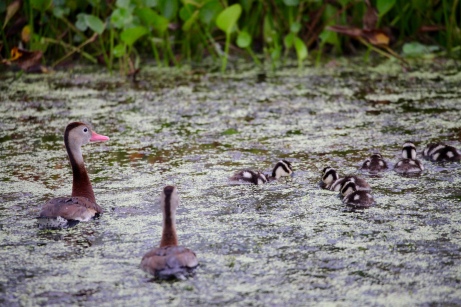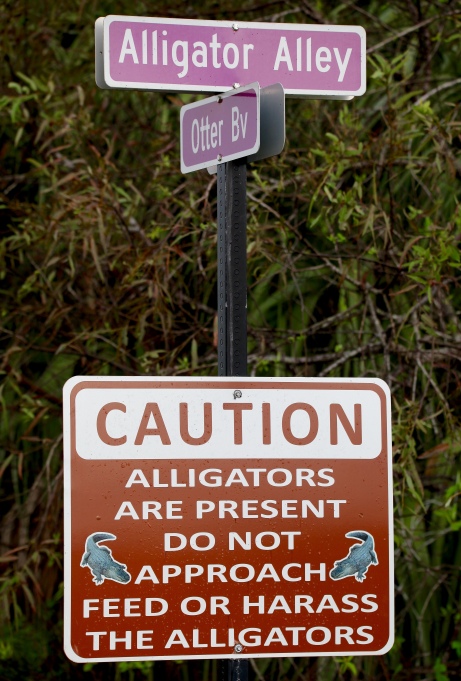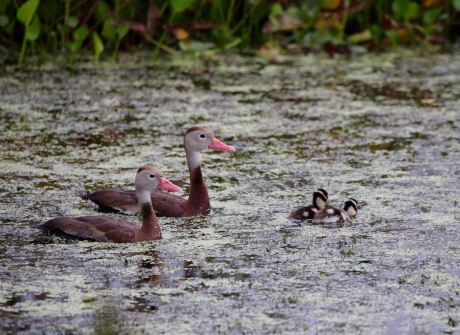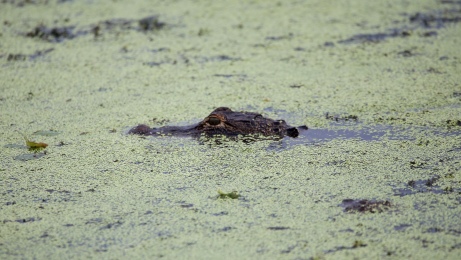The Black-bellied Whistling Duck (BBWD) above was the designated sentinel of the day, keeping a close watch over the 15 or more fluffy, black and yellow ducklings swimming about nearby with their ‘guardians’. It had been raining all day, and the worst of a severe thunderstorm had just passed. We surmised later that it may have been a precursor to Hurricane Florence, which was then brewing in the Caribbean and heading toward the southeast U.S.
It had been raining all day, and the worst of a severe thunderstorm had just passed. We surmised later that it may have been a precursor to Hurricane Florence, which was then brewing in the Caribbean and heading toward the southeast U.S.
The Black-bellied Whistling ducklings are barely perceptible in the above video, as they were at quite a distance from the trail. Watched over by caregivers, they were scooting about very close to the marshy vegetation, where they could flee in a hurry in case of danger.
 This sign above, typical of the sort of cautionary signs we see everywhere in Florida wetlands and marshy areas, was undoubtedly meant for humans, in every season.
This sign above, typical of the sort of cautionary signs we see everywhere in Florida wetlands and marshy areas, was undoubtedly meant for humans, in every season.  But Black-bellied Whistling Duck parents would do well to heed the warning, too. We spotted lots of ‘low-lying’, well camouflaged ‘gators lurking nearby. The very protective American Alligator moms are also watching over their own nests and hatchlings at this time of year.
But Black-bellied Whistling Duck parents would do well to heed the warning, too. We spotted lots of ‘low-lying’, well camouflaged ‘gators lurking nearby. The very protective American Alligator moms are also watching over their own nests and hatchlings at this time of year.  Some research maintains that there is “no real evidence that alligators are an important predator” of the Whistling Ducks. However, I trust this reminder from the Florida Fish & Wildlife Commission:
Some research maintains that there is “no real evidence that alligators are an important predator” of the Whistling Ducks. However, I trust this reminder from the Florida Fish & Wildlife Commission:
“Alligators are opportunistic feeders. Their diets include prey species that are abundant and easily accessible. . . . Adult alligators eat rough fish, snakes, turtles, small mammals, and birds.”
In other words, when asked, “What do Alligators eat?”, the most accurate response is probably, “Whatever they want!!”


What a pleasure to see these beautiful ducks and their babies!
LikeLiked by 1 person
They are always a treat to see! We call them “bumblebee ducklings”!
LikeLiked by 1 person
How cute!!! 🙂 🙂
LikeLiked by 1 person
Such adorable ducklings! I’ve only seen BBWD’s once on a Florida trip couple years ago, you cannot imagine how excited I was to sight them around a pond and hear them I flight! Definitely a beautiful, unique duck!
LikeLiked by 1 person
Yes, I love the way they sing in flight. You can hear the adults flying over a teeny bit in the background on the video clip in this post.
LikeLiked by 1 person
The ducklings are adorable!
LikeLiked by 1 person
Yes, aren’t they? They’re so far away but at least the other related posts show these little fluff balls close up ☺️
LikeLike
Aww, the ducklings are so cute! I hope the gators have other meal plans and they stay safe.
LikeLiked by 1 person
I hope so, too! We’ve had several broods of vulnerable little baby alligators here in our area this year, and sadly, they, too, are diminishing in number week by week.
LikeLike